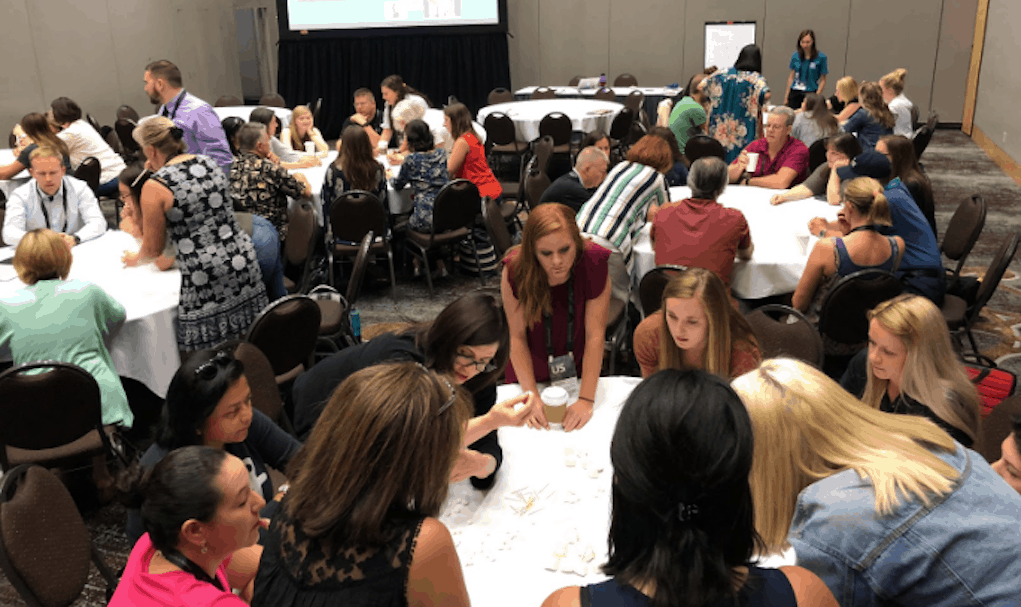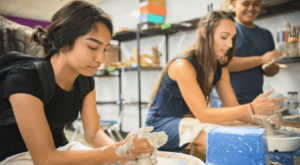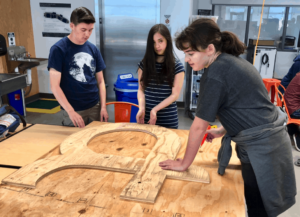The Power of Us: A Network Powering Projects, Changing Lives

More than 1,400 educators from more than 150 schools across the U.S. and from Australia braved a little July humidity in St. Louis to further activate their network of schools committed to powerful learning.
The New Tech Network is a group of 200+ predominately public district elementary and secondary schools committed to integrated team-taught project-based learning. The Network, formed in 2000 around the early success of Napa New Tech High, gathered at NTAC18 over the weekend.
Like me, these educators have concluded that extended community-connected challenges that result in public products are the best way to develop #FutureReady humans by building student agency and collaboration while teaching communication and project management skills.
The Power of Us
Rather than kicking off with a keynote, the conference opened with a max mix design thinking exercise (featured image). It featured a tough challenge with inequitable resources, teams comprised of people who didn’t know each other, and a short timeline (all conditions pretty familiar to educators). It illustrated the conference theme–The Power of Us.
NTN CEO Lydia Dobyns explained that the theme was part of a three year arch to reconnect members of the network to a bigger aim. In 2016, the conference focus was combining the skill building aspects of personalized learning with engaging project-based learning. Last year the network concentrated on connecting to the equity challenge in each of their school communities. This year’s, NTAC theme centered on members giving to, as well as receiving from, the network. Dobyns explained that by activating your network with contributions you almost always get back more than you gave.
The goal, said Dobyns, “is to become more than a “knowledge ecosystem network” where our shared purpose, our reason to engage in network weaving, centers itself around closing the opportunity gap.”
“We were inspired, humbled, and encouraged by the willingness of school and district teams to roll up their sleeves on what New Tech Network can mean,” added Dobyns.

Better Together
Dobyns and I teamed up to write a new book, “Better Together,” to highlight the exciting ways that school networks are supporting educators and expanding access to deeper learning.
Educators working together has always been important but with the development of personalized learning, education has become a team sport. It’s critical for school teams to work together. And, because personalized learning models are complicated, especially when you combine it with project-based learning–it’s helpful to link schools together in networks that share models, tools, and professional learning experiences.
Our new book, Better Together: How to Leverage School Networks for Smarter Personalized and Project Based Learning, outlines the formal and informal ways that educators can work smarter together to benefit all students.
Generative collaborations, like New Tech Network, where teachers can author as well as adopt lessons, where they can contribute as well as benefit, have a chance to achieve network effect and get better as they get bigger. The noteworthy impact of the New Tech Network (higher graduation and college persistence rates and demonstrated student growth across a range of settings) is a positive trajectory.

Awarded Work
A two day competition styled after the popular cooking show Chopped, pitted teams from around the country and each round featured mystery ingredients that included three standards and a New Tech learning outcome. In just a few minutes the teams had to author a project design that engaged students and hit the standards and outcomes.
Eagle Tech High from Columbia City Indiana emerged victorious from the heated battle (above).
Patrick Gallucci, First State Military Academy (below), was recognized for his leadership in the first ROTC school in the New Tech Network. Serving racially and culturally diverse students in Southern Delaware, FSMA has a powerful culture spirited by a talented group of teachers, most of which were new to project-based learning. The commandant preaches “culture over content” and encourages his teachers to take risks in their practice.

As a first year member of the network, teachers from Burke High School in Charleston South Carolina won the Best in Network Award for their Finding a Voice project which asked students to design graphic novels about disenfranchised and marginalized groups around the world. Teachers Amelia Navarrete and Edgar Johnson combined objectives from government and world literature to create a powerful project. With help from the local library, students conducted research and wrote first-person narratives about someone in their region and storyboarded all the panels of their graphic novel.
For more on New Tech Network see:
- New Tech Network Powers A Common Learning Model and Unique Missions
- El Paso and New Tech Network: District Transformation in High Gear
Stay in-the-know with all things edtech and innovations in learning by signing up to receive the weekly Smart Update. This post includes mentions of a Getting Smart partner. For a full list of partners, affiliate organizations and all other disclosures, please see our Partner page.





0 Comments
Leave a Comment
Your email address will not be published. All fields are required.